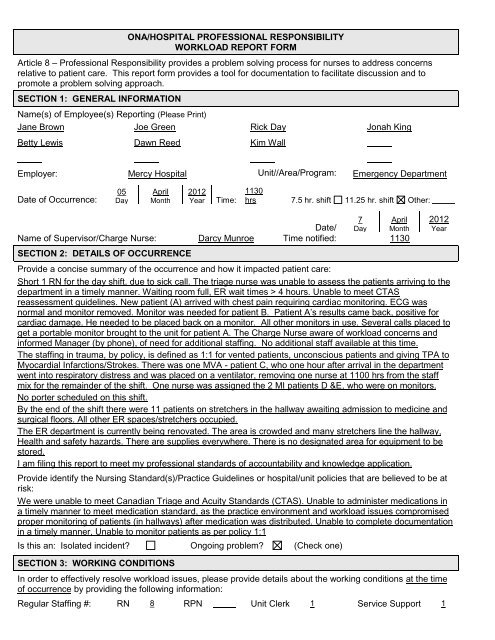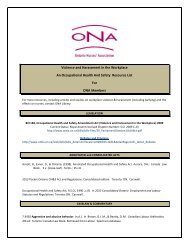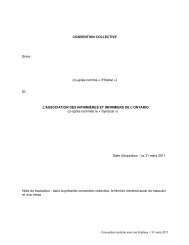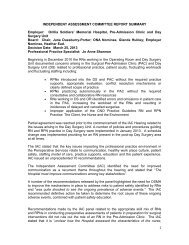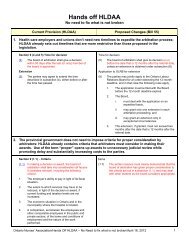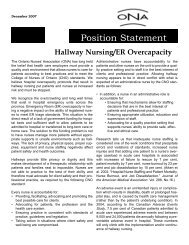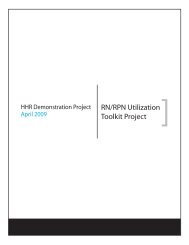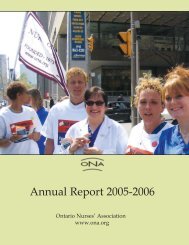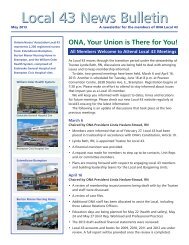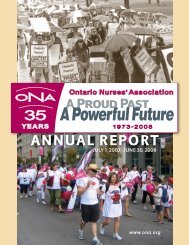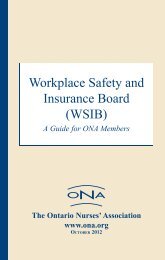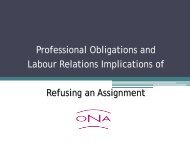Professional Responsibility Workload Report Form SAMPLE ...
Professional Responsibility Workload Report Form SAMPLE ...
Professional Responsibility Workload Report Form SAMPLE ...
You also want an ePaper? Increase the reach of your titles
YUMPU automatically turns print PDFs into web optimized ePapers that Google loves.
ONA/HOSPITAL PROFESSIONAL RESPONSIBILITY<br />
WORKLOAD REPORT FORM<br />
Article 8 – <strong>Professional</strong> <strong>Responsibility</strong> provides a problem solving process for nurses to address concerns<br />
relative to patient care. This report form provides a tool for documentation to facilitate discussion and to<br />
promote a problem solving approach.<br />
SECTION 1: GENERAL INFORMATION<br />
Name(s) of Employee(s) <strong>Report</strong>ing (Please Print)<br />
Jane Brown Joe Green Rick Day Jonah King<br />
Betty Lewis Dawn Reed Kim Wall<br />
Employer: Mercy Hospital Unit//Area/Program: Emergency Department<br />
Date of Occurrence:<br />
05<br />
Day<br />
April<br />
Month<br />
2012<br />
Year<br />
Time:<br />
1130<br />
hrs 7.5 hr. shift 11.25 hr. shift Other:<br />
Date/<br />
7 April<br />
Day Month<br />
Name of Supervisor/Charge Nurse: Darcy Munroe Time notified: 1130<br />
SECTION 2: DETAILS OF OCCURRENCE<br />
Provide a concise summary of the occurrence and how it impacted patient care:<br />
Short 1 RN for the day shift, due to sick call. The triage nurse was unable to assess the patients arriving to the<br />
department in a timely manner. Waiting room full, ER wait times > 4 hours. Unable to meet CTAS<br />
reassessment guidelines. New patient (A) arrived with chest pain requiring cardiac monitoring. ECG was<br />
normal and monitor removed. Monitor was needed for patient B. Patient A’s results came back, positive for<br />
cardiac damage. He needed to be placed back on a monitor. All other monitors in use. Several calls placed to<br />
get a portable monitor brought to the unit for patient A. The Charge Nurse aware of workload concerns and<br />
informed Manager (by phone), of need for additional staffing. No additional staff available at this time.<br />
The staffing in trauma, by policy, is defined as 1:1 for vented patients, unconscious patients and giving TPA to<br />
Myocardial Infarctions/Strokes. There was one MVA - patient C, who one hour after arrival in the department<br />
went into respiratory distress and was placed on a ventilator, removing one nurse at 1100 hrs from the staff<br />
mix for the remainder of the shift. One nurse was assigned the 2 MI patients D &E, who were on monitors.<br />
No porter scheduled on this shift.<br />
By the end of the shift there were 11 patients on stretchers in the hallway awaiting admission to medicine and<br />
surgical floors. All other ER spaces/stretchers occupied.<br />
The ER department is currently being renovated. The area is crowded and many stretchers line the hallway,<br />
Health and safety hazards. There are supplies everywhere. There is no designated area for equipment to be<br />
stored.<br />
I am filing this report to meet my professional standards of accountability and knowledge application.<br />
Provide identify the Nursing Standard(s)/Practice Guidelines or hospital/unit policies that are believed to be at<br />
risk:<br />
We were unable to meet Canadian Triage and Acuity Standards (CTAS). Unable to administer medications in<br />
a timely manner to meet medication standard, as the practice environment and workload issues compromised<br />
proper monitoring of patients (in hallways) after medication was distributed. Unable to complete documentation<br />
in a timely manner, Unable to monitor patients as per policy 1:1<br />
Is this an: Isolated incident Ongoing problem (Check one)<br />
SECTION 3: WORKING CONDITIONS<br />
In order to effectively resolve workload issues, please provide details about the working conditions at the time<br />
of occurrence by providing the following information:<br />
Regular Staffing #: RN 8 RPN Unit Clerk 1 Service Support 1<br />
2012<br />
Year
Actual Staffing #: RN 7 RPN Unit Clerk 1 Service Support 0<br />
Agency/Registry RN: Yes No How many<br />
Novice RN Staff on duty* Yes No How many 2<br />
RN Staff Overtime: Yes No If yes, how many staff 1<br />
*as defined by your unit/area/program.<br />
If there was a shortage of staff at the time of the occurrence, (including support staff) please check one or all of<br />
the following that apply:<br />
Absence/Emergency Leave Sick Call(s) Vacancies Off unit<br />
- 2 -<br />
Management Support available on site Yes No<br />
SECTION 4: PATIENT CARE FACTORS CONTRIBUTING TO THE OCCURRENCE<br />
Please check off the factor(s) you believe contributed to the workload issue and provide details:<br />
Change in patient acuity.<br />
MI requiring monitoring and MVA being ventillated in dept. Patient census at time of occurrence started<br />
shift with 25 of 26 beds filled. At end of the shift all 26 beds filled and 11 patients on stretchers in the<br />
hallway. Cardiac Care Unit full and had to await transfers from there before they could take our patients<br />
Normal number of beds on unit 26 Beds closed<br />
Beds opened during tour<br />
Patient census at time of occurrence 37 Patient census at start of shift was 25 of 26 beds filled. At end of<br />
the shift all 26 beds filled and 11 patients on stretchers in the hallway. Cardiac Care Unit full and had to wait for<br />
patients to be transferred out before they could take our patients<br />
# of Admissions 12 # of Discharges # of Transfers<br />
Lack of/or equipment/malfunctioning equipment. Please specify:<br />
Unable to locate equipment due to space issues during construction and lack of monitors for all patients, 2<br />
monitors not working, waiting to be repaired, charge nurse making several calls for a monitor, lack of IV<br />
poles, and IVAC machines. Ward Clerk had to call to the floors to get equipment returned. Two portable<br />
cardiac monitors not working and awaiting maintenance/repair by engineering<br />
Visitors/Family Members. Please specify:<br />
Visitors demanding and angry, with lengthy wait times<br />
Number of patients on infectious precautions<br />
Over Capacity Protocol. Please specify:<br />
11 patients in hallways<br />
Resources/Supplies Supplies relocated due to construction/unable to locate necessary supplies or<br />
unavailable<br />
Interdepartmental Challenges<br />
System Issues<br />
Exceptional Patient Factors (i.e. significant time and attention required to meet patient expectations).<br />
Please specify:<br />
Patient requiring ventilation in department for extended period of time<br />
Other: (e.g. Non-nursing duties, student supervision, mentorship, etc.) Please specify:<br />
Novice staff requiring support and assistance with new and highly complex patients<br />
SECTION 5: REMEDY<br />
(A) At the time the workload issue occurs, discuss the issue within the unit/area/program to develop strategies<br />
to meet patient care needs. Provide details of how it was or was not resolved:<br />
Nurses on the unit discussed changing patient census, acuity and volumes of patients to try to develop a<br />
plan of action. Determined that additional staffing was required in order to meet the needs of the patients<br />
for safe, quality care
(B) Failing resolution at the time of the occurrence, seek immediate assistance from an individual(s) who has<br />
responsibility for timely resolution of workload issues. Discussion details including name of individual(s):<br />
<strong>Report</strong>ed to Charge Nurse and Manager (by phone), calls placed for additional staff and told to do the best<br />
we can in the interim. No additional staff was provided.<br />
Was it resolved Yes No<br />
SECTION 6: RECOMMENDATIONS<br />
Please check-off one or all of the areas below you believe should be addressed in order to prevent similar<br />
occurrences:<br />
Inservice Orientation Review nurse/patient ratio<br />
Change unit lay-out Float/casual pool Review policies & procedures<br />
Change Start/Stop times of shift(s). Please specify:<br />
- 3 -<br />
Review <strong>Workload</strong> Measurement Statistics<br />
Perform <strong>Workload</strong> Measurement Audit<br />
Adjust RN staffing<br />
Adjust support staffing<br />
Replace sick calls, vacation, paid holidays, other absences<br />
Equipment. Please specify:<br />
Ensure that all equipment in the department is placed on a routine maintenance schedule, increase<br />
number of cardiac monitors<br />
Other:<br />
Post and fill vacancies created by staff on extended sick/LTD until their return, increase part time<br />
resources, utilize accommodated RN in waiting room to complete reassessments and assist triage to meet<br />
the CTAS standards<br />
SECTION 7: EMPLOYEE SIGNATURES<br />
Signature:<br />
Jane Brown<br />
Phone # / Personal E-mail:<br />
jbrown@hotmail.com<br />
Signature:<br />
Dawn Reed<br />
Phone # / Personal E-mail:<br />
603-234-9876<br />
Signature:<br />
Joe Green<br />
Phone # / Personal E-mail:<br />
603-234-7654/greener@yahoo.ca<br />
SECTION 8: MANAGEMENT COMMENTS<br />
The manager (or designate) will provide a written response to the nurse (s) within 5 days of receipt of the form<br />
with a copy to the Bargaining Unit President as per Article 8.01 (a) iii). Please provide any information/<br />
comments in response to this report, including any actions taken to remedy the situation, where applicable.<br />
Management Signature:<br />
Date response to the employer:<br />
Date:<br />
Date response to the union:<br />
SECTION 9: RECOMMENDATIONS OF HOSPITAL-ASSOCIATION COMMITTEE<br />
The Hospital-Association Committee recommends the following in order to prevent similar occurrences:
Dated:<br />
Copies: (1) Manager<br />
(2) ONA Rep<br />
(3) Chief Nursing Officer (or designate)<br />
(4) ONA Member<br />
(5) LRO<br />
- 4 -
- 5 -<br />
ONA/HOSPITAL PROFESSIONAL RESPONSIBILITY - WORKLOAD REPORT FORM<br />
GUIDELINES AND TIPS ON ITS USE<br />
The parties have agreed that patient care is enhanced if concerns relating to professional practice, patient acuity,<br />
fluctuating workloads and fluctuating staffing are resolved in a timely and effective manner. The collective<br />
agreement provides a problem solving process for nurses to address concerns relative to patient care. This report<br />
form provides a tool for documentation to facilitate discussion and to promote a problem-solving approach.<br />
PRIOR TO SUBMITTING THE WORKLOAD REPORT FORM PLEASE FOLLOW THE PROBLEM SOLVING<br />
PROCESS BELOW AND AS OUTLINED IN THE COLLECTIVE AGREEMENT ARTICLE 8.<br />
PROBLEM SOLVING PROCESS<br />
1) At the time the workload issue occurs, discuss the matter within the Unit/Area/Program to develop strategies<br />
to meet patient care needs using current resources. Using established lines of communication, seek<br />
immediate assistance from an individual identified by the Employer (e.g. team leader/charge nurse/coordinator/supervisor)<br />
who has responsibility for timely resolution of workload issues.<br />
2) Failing resolution of the workload issue at the time of the occurrence, discuss the issue with the Manager (or<br />
designate) on the next day that both the employee and Manager (or designate) are working or within five (5)<br />
calendar days, whichever is sooner, and complete the form.<br />
3) When meeting with the manager, you may request the assistance of a Union representative to support/assist<br />
you in the meeting. Every effort will be made to resolve the workload issues at the unit level. A Union<br />
representative shall be involved in any resolution discussions at the unit level. All discussions and action will<br />
be documented.<br />
4) Failing resolution, submit the <strong>Professional</strong> <strong>Responsibility</strong> <strong>Workload</strong> <strong>Report</strong> <strong>Form</strong> to the Hospital-Association<br />
Committee within twenty (20) calendar days from the date of the Manager’s response or when she or he<br />
ought to have responded under Article 8.01 (a)(iii). (SEE BLANK REPORT FORM ATTACHED TO THESE<br />
GUIDELINES.)<br />
5) As per Article 8, the Hospital-Association Committee shall hear and attempt to resolve the complaint to the<br />
satisfaction of both parties. Any settlement/resolution under 8.01 (a)(iii) (iv) or (v) of the collective agreement<br />
will be signed by the parties.<br />
6) If the issue remains unresolved it shall be forwarded to an Independent Assessment Committee as outlined in<br />
Article 8 of the Collective Agreement within the requisite number of days of the meeting in 4) above.<br />
7) The Union and the Employer may mutually agree to extend the time limits for referral of the complaint at any<br />
stage of the complaint procedure.<br />
TIPS FOR COMPLETING THE FORM<br />
1) Review the form before completing it so you have an idea of what kind of information is required.<br />
2) Print legibly and firmly as you are making multiple copies.<br />
3) Use complete words as much as possible. Avoid abbreviations.<br />
4) As much as possible, you should report only facts about which you have first-hand knowledge. If you use<br />
second-hand or hearsay information, identify the source if permission is granted.<br />
5) Identify the CNO standards/practice/guidelines/hospital policies and procedures you believe to be at risk.<br />
College of Nurses Standards can be found at www.cno.org.<br />
6) Do not, under any circumstances, identify patients/residents.


